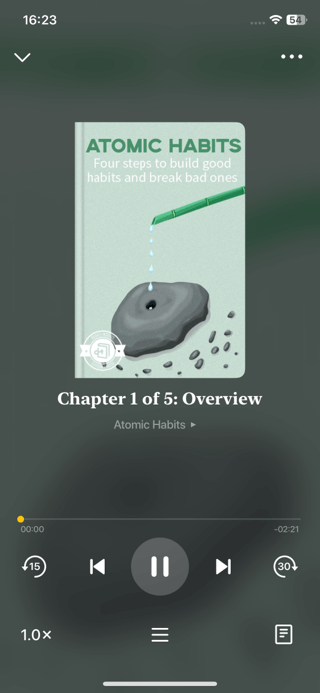Last updated on 2025/05/04
Brit Summary
Afua Hirsch
Exploring identity in a post-colonial Britain.
Last updated on 2025/05/04
Brit Summary
Afua Hirsch
Exploring identity in a post-colonial Britain.
Description

How many pages in Brit?
367 pages
What is the release date for Brit?
In "Brit," Afua Hirsch embarks on a profound exploration of identity, belonging, and the intricate tapestry of British society through her own lens as a woman of mixed heritage. With poignant personal narratives and incisive cultural observations, Hirsch challenges the conventional notions of race, nationality, and what it means to be truly British in a world rife with both diversity and division. This thought-provoking memoir invites readers to reflect on their own identities and the ever-evolving landscape of a nation grappling with its past while striving to embrace its future. Hirsch's eloquent prose and candid reflections make "Brit" a compelling read for anyone seeking to understand the complexities of modern Britain and the struggle of fitting into a society that often demands conformity.
Author Afua Hirsch
Afua Hirsch is a British writer, broadcaster, and human rights lawyer, renowned for her insightful commentary on issues of identity, race, and culture. Born to a Ghanaian father and a British mother, Hirsch's mixed heritage deeply influences her work, allowing her to navigate and challenge the complexities of modern Britain. She has contributed to various international publications, including The Guardian and BBC, and is celebrated for her articulate and thought-provoking perspectives. With her debut book, "Brit," Hirsch draws on her experiences to explore the themes of belonging and national identity, offering a profound reflection on the realities of being a Black Briton in an often divided society.
Brit Summary |Free PDF Download
Brit
Chapter 1 | Where Are You From?
In her compelling narrative, Afua Hirsch navigates the complex and often fraught relationship between identity, culture, and belonging as reflected through her name and her experiences growing up in Britain. Growing up, Hirsch grapples with the pronunciation of her name, "Afua," a seemingly simple, four-letter word that becomes a symbol of her struggle with her identity. She contemplates the phonetic intricacies that make it difficult for many to say it correctly, reflecting on a broader phenomenon affecting the Ghanaian diaspora in Britain, where names carry deep cultural significance often lost in translation. This mispronunciation becomes a metaphor for the disconnect between her Ghanian heritage and her existence in predominantly white British society. As Hirsch reflects on the question "Where are you from?" which she is frequently asked, she articulates the discomfort this query brings. It serves as a reminder of her otherness in a country where she has lived her entire life. While innocently posed by curious individuals, it signifies a deeper struggle within Britain to understand and integrate diverse identities. For her, it raises existential questions about belonging and identity: Can she be truly British if she is continually reminded of her difference? Her family history unfolds against the backdrop of significant global events. Hirsch narrates her grandfather's escape from Nazi Germany and the cultural implications of changing his name to fit into British society. This historical context deepens the complexity of her identity, rooted both in her Jewish heritage and her Ghanaian roots. The naming tradition in her family, steeped in Akan customs, illustrates her parents’ wishes to connect her to her ancestral land despite the challenges of upbringing in an English context. Hirsch's narrative also captures her journey of self-discovery which is set in motion during a transformative trip to Ghana with her family. Packed into a vehicle with three generations of her family, they embark on a journey filled with anticipation but also a stark realization of the realities of corruption, cultural misunderstanding, and the evolution of her identity. During this trip, she becomes acutely aware of the complexities of Ghana's past and present, informed by her British upbringing but keen to connect with her heritage. Ghana represents not just a geographical space for Hirsch but embodies a deep emotional and cultural longing. The contrasting imagery of life in Wimbledon, a predominantly white English suburb, evokes memories that highlight her feelings of being an outsider. Throughout her childhood, she felt invisible, characterized as "other," and despite her mother’s confidence and beauty, she grappled with her own sense of shame regarding her identity. The narrative builds tension around her internal conflicts—struggling to reconcile the two parts of her heritage while being shaped by societal perceptions of race and identity. Her hair, once a tool of alienation, becomes a point of connection and transformation when she adopts traditional African braids, defining a new identity that embraces her blackness and allows her to flow more easily into the black community she yearns to belong to. However, while Hirsch finds empowerment in embracing her black identity, she acknowledges her ignorance of the cultural heritage and history tied to it. This gaps lead to the exploration of her roots, culminating in her first visit to Ghana, where she experiences a sense of belonging that she had previously been denied in Britain. She describes the initial exhilaration upon seeing a landscape populated by black individuals, a stark contrast to her earlier experiences. During her time in Ghana, Hirsch discovers the difficult intertwining of British history with her own family's narrative, especially regarding colonial legacies. Her visit to Aburi, where her ancestor found refuge, poignantly connects her past with the present, enriching her sense of identity while also challenging preconceived notions of what it means to belong. Ultimately, Hirsch’s story is an intricate tapestry of personal reflection, historical exploration, and cultural reclamation. Through her journey, she reveals the inherent complexities of identity that arise from living between cultures, urging readers to ponder the nuanced histories that shape our present and influence how we perceive belonging in a world grappling with issues of race, heritage, and individual narratives.
Key Point: Embracing Complexity in Identity
Critical Interpretation: As you navigate your own life, let Afua Hirsch’s journey remind you that your identity is not a singular narrative, but rather a complex tapestry woven from the threads of history, culture, and personal experience. Just as she found strength in the multifaceted nature of her heritage, you can draw inspiration from the various aspects of your own background, embracing the richness they bring to your story. In a world that often tries to box individuals into neat categories, celebrate the beautiful chaos of your identity and allow it to shape your understanding of belonging. This embracing of complexity can empower you to forge connections with others and cultivate a more inclusive perspective, paving the way for deeper conversations about race, culture, and what it truly means to belong.
Chapter 2 | Origins
In exploring the multifaceted history of black presence in Britain, Chapter 2 of "Brit" by Afua Hirsch intricately connects past and present, challenging preconceived notions about race and identity. Throughout the chapter, Hirsch presents a narrative enriched with personal anecdotes and critical reflections on the socio-historical context, particularly regarding the roles historical figures and societal structures played in shaping the national identity of Britain. 1. The chapter opens with the author receiving images of Victorian and Edwardian black women, which surprises her and her friends. This revelation is stirring for them, as it contrasts sharply with the limited representations of black individuals in historical narratives stemming from their upbringing. These images prompt reflections on the invisibility of black contributions to British history, challenging the narratives shaped by the educational system, which traditionally sidelines black experiences. 2. Hirsch reflects on her mother’s experiences of growing up during the 1960s when there was scant acknowledgment of black history in Britain. The absence of "black history" in educational curricula leads to a lack of awareness about the significant roles played by blacks in British history. However, thanks to the efforts of historians who have since highlighted these contributions, aspects of black history are beginning to find their way into the public consciousness, albeit within a narrow time frame, often solely during Black History Month. 3. The author contemplates the irony surrounding Britain's commemoration of abolition while simultaneously neglecting its extensive participation in the slave trade. While events celebrating the abolition of slavery through figures like William Wilberforce are widely recognized, there is little attention paid to the complicity of various institutions, including the monarchy, in the proliferation of slavery. 4. A central aspect of Hirsch's critique revolves around the misrepresentation and simplification of history, particularly in children’s literature and the educational narrative, which often renders slavery as an unfortunate footnote in British history rather than examining its deep-rooted implications and the ongoing ramifications of its legacy. 5. The narrative shifts to highlight the African diaspora's struggles within Britain, illustrating that the historical contributions and struggles of black people have often been obfuscated or rendered inconsequential to the broader societal narrative. Hirsch emphasizes the need to dismantle these narratives—both academically and socially—fostering a broader understanding among future generations about the interconnectedness of British and African histories. 6. The chapter also touches on racial identities today, contrasting the resilience of contemporary black youth with the outdated narratives that once sought to define identity through a colonial lens. Hirsch draws attention to the stereotyping of African identities, illustrating how deeply ingrained biases affect perceptions of black individuals and their contributions to society. 7. Hirsch reflects on her encounters with historical figures who fought against the stigma surrounding black identities, such as Olaudah Equiano and Ignatius Sancho, who emerged as strong voices against racial discrimination and participated actively in the abolitionist movement. Their stories serve as critical reminders of the vitality and complexity of black historical figures who fought for freedom and recognition. 8. The author considers how Britain’s colonial past shapes current identities, both for individuals of mixed heritage and for society as a whole. She emphasizes the importance of understanding this history not to impose guilt but to enrich Britain's national narrative, acknowledging the shared cultural heritage that connects all people in the UK. 9. Hirsch advocates for an educational reform that emphasizes a holistic understanding of British history—one that incorporates the narratives of all people who have contributed to its development, breaking away from the notion that history can be celebrated without confronting its darker aspects. In summary, Chapter 2 of "Brit" argues for the necessity of revisiting and reconstructing historical narratives to create a more inclusive account that acknowledges the legacies of both black and white individuals in shaping Britain's identity. By addressing the complexities of history, Hirsch seeks a path toward a reconciled identity that embraces the richness of Britain's diverse past and present.
Chapter 3 | Bodies
In the small town of Duntable, the cold night of November 2016 sets the scene as the narrator, accompanied by her friend Miranda, ventures into a place that serves as a microcosm of racial dynamics, sexual desires, and societal norms. They arrive at a venue known as the Black Man’s Fan Club, a swinging night designed for white women who wish to engage with black men, and their partners who take part as spectators. This environment straddles the line between a night out and the grotesque reality of racial fetishization. 1. The narrator's experience highlights the stark contrast between her and Miranda, who feels more at ease, while the narrator grapples with insecurities about her appearance, exacerbated by the choice to use a pseudonym that aligns with a Jewish identity as a protective measure against racial bias. The chilling encounter exposes them to an unsettling mix of casual voyeurism and complex narratives surrounding race and sexuality. 2. In a chaotic space where sexual encounters seem transactional, the men, often categorized as performers of racial stereotypes, embrace the notion of heightened virility and sexual prowess historically associated with black men. The conversation turns to entrenched notions of fetishization, where such stereotypes are both a source of cultural currency for some men, but also a landscape of internal conflict for them and the women they attract. 3. The narrator becomes increasingly conscious of the broader implications of this scene; she recognizes it not merely as a space of sexual liberation but as a troubling reinforcement of historic racial stereotypes. The mingling of pleasure, exploitation, and racialized desires creates a complicated tableau, where desires are juxtaposed against the backdrop of ongoing racial prejudice. 4. The portrayal of black bodies in a plethora of cultural narratives further intensifies the uncomfortable awareness of systemic racist beliefs. Historical representations, from colonial times to contemporary media, have not only distorted perceptions of black sexuality but perpetuated the idea of black men as either hypersexual threats or objects of desire. The narrator's reflections prompt a deeper dive into the societal narratives that have shaped these views and the painful history that lingers. 5. Amidst discussions of race and representation, the narrator recounts her own experiences of growing up, revealing the intersection of her identity as a black woman and the challenges of navigating societal perceptions. The impact of being seen through a lens of stereotype underscores the complexities of belonging—often feeling invisible or hyper-visible within contexts that highlight racial differences. 6. The stark contrast between the romanticized idea of interracial relationships and the sobering reality of fetishization adds depth to the narrator’s experiences. The pervasive notion that black women are inherently sexualized extends beyond societal interactions, creating obstacles in dating and relationship dynamics, often leading to feelings of inadequacy, suspicion, and frustration within black women who seek genuine connection. 7. These intricate patterns of perception are mirrored in broader cultural trends, such as beauty standards, where black women's features are undervalued or maligned. The quest for acceptance and validation within the beauty industry is fraught with contradictions that leave many feeling compelled to conform to Eurocentric beauty ideals, leading to a complex relationship with self-image and belonging. 8. The chapter culminates in a reflection on shifting societal paradigms surrounding race, identity, and acceptance. The narrator argues for a re-examination of race relations in contemporary Britain, challenging the notion that racism has simply evolved into a milder form of prejudice. By articulating the myriad ways that race still significantly shapes experiences, she advocates for a confrontation of the historic and ongoing complexities of racial identity. Through the painting of this disturbing yet revealing picture of racial fetishization, personal identity struggles, and the discomforting realities of being a black woman in contemporary society, the chapter addresses the nuances of race, body politics, and sexuality, urging readers to consider the deep-rooted and pervasive impacts of historical narratives still alive today.
Chapter 4 | Heritage
Chapter 4 of "Brit" by Afua Hirsch explores intricate themes of identity, race, and heritage, largely through the experiences of Lola, a woman of mixed heritage who runs a care home. The chapter opens with a reflection on the complexities of belonging to multiple cultures and grappling with personal identity in a society where these identities often clash. 1. The Journey Through Multiple Identities: Lola’s life encapsulates the duality of navigating between cultures. Born to Nigerian parents in a predominantly white environment, she finds herself constantly reconciling her Nigerian heritage with her British upbringing. This duality reflects the struggles of living within two worlds, with tensions stemming from societal perceptions and personal experiences. Her narrative reveals the impactful intersection of race and identity: Lola identifies as both black and British, yet feels the weight of societal expectations and biases that come with her skin color. 2. Environmental Reflections: The chapter skilfully depicts the physical landscapes of London as reflective of the socio-economic divides and cultural variances. The District Line Tube serves as a metaphor for the journey through this divided city, moving from downtrodden areas like Elm Park to wealthier zones. Through this lens, we see different ethnic groups boarding the same train yet on separate journeys—each representing the complex fabric of London’s multicultural identity. 3. Life in Care: Lola’s motivation to create a high-quality care environment for at-risk youth stems from her own childhood experiences in the care system. Her upbringing in a white foster family left her grappling with a lack of cultural education and identity affirmation. Lola’s determination to provide a nurturing space for children in care is rooted in a desire to address their emotional and cultural needs, which she felt were neglected during her own formative years. 4. Cultural Insecurity and Assimilation: Lola’s story is fraught with cultural insecurity, as she navigates her identity in predominantly white spaces. Despite being raised in a diverse environment, she initially felt disconnected from black culture. Her journey reflects a common experience among mixed-race individuals who often find themselves questioned about their identity by both black and white peers. Such societal pressure reveals the complications of self-identification in a world that insists on binary categories. 5. The Impact of Race Matching Policies: Lola’s narrative emphasizes the historical context of race and adoption policies in Britain, illustrating the struggles faced by black and mixed-race children in predominantly white systems. These policies have evolved but can still be detrimental, impacting the fostering and adoption processes. Lola argues that while race matching has its flaws, it still plays a critical role in ensuring that children maintain connections to their cultural identities. 6. Historical Context of Mixed-Race Identity: The chapter provides a historical backdrop to the current discourse surrounding race in Britain, reflecting on the implications of mixed heritage. It examines how deeply ingrained societal biases have affected perceptions of black and mixed-race individuals throughout history. The complexities and prejudices associated with race highlight the ongoing challenges in accepting and celebrating diversity in contemporary Britain. 7. Navigating Future Identities: Looking ahead, the chapter discusses the importance of embracing the fluidity of identity in a rapidly changing society. As demographic trends show increasing interracial relationships and mixed-race identities, the conversation shifts towards acceptance and understanding of these identities. The need for nuanced discussions about race and heritage is emphasized, advocating for a society that honors personal stories and experiences rather than imposing restrictive categorizations. In concluding the chapter, Hirsch eloquently encapsulates the ongoing struggles of those with complex identities. By weaving personal anecdotes with broader societal observations, she invites readers to reflect on the richness and challenges of multiculturalism and the evolving understanding of race in Britain. The narrative serves not only as a personal exploration but also as a crucial commentary on the cultural dynamics at play within modern society.
Key Point: Embracing the Fluidity of Identity
Critical Interpretation: As you navigate through life, consider how the journey Lola undertakes in reconciling her mixed heritage can inspire you to embrace the fluidity of your own identity. In a world that often tries to fit people into rigid categories, allow yourself the freedom to explore the various aspects of who you are, recognizing that identity is not a static label but a dynamic tapestry woven from experiences, culture, and personal growth. Reflect on the power of your unique story, and let go of societal pressures that seek to define you in narrow terms. By celebrating the richness of your multifaceted identity, you can foster a deeper understanding of yourself and others, championing diversity and inclusivity in every space you occupy.
Chapter 5 | Places
In "Brit," Afua Hirsch navigates the complex themes of identity, belonging, and cultural heritage through her transformative experiences in Senegal and Ghana. Hirsch's journey begins with a compelling opening that references the void between her upbringing in Britain and her familial ties to Africa, as she grapples with her fragmented sense of self. Hirsch's optimism is evident as she embarks on a new life in Dakar, Senegal, representing a search for an authentic identity. As part of the founding team for George Soros’s Open Society Foundation, she engages in meaningful work supporting journalists and legal clinics in a region marked by historical and socioeconomic challenges. This phase of her life is characterized by an enthusiastic embrace of 'Afro-optimism,' embodying a generational shift among young Senegalese who reject the Eurocentric ideals of their parents in favor of local aspirations and innovations. However, her initial idealism fades as she confronts harsh realities, such as the infrastructure issues affecting her new friends—many of whom are forced to leave Senegal for better opportunities abroad, a painful echo of the continent's broader struggles with brain drain. As expatriate friendships form but also fall short, Hirsch begins to feel the weight of her identity as a foreigner, leading her to reflect deeply on what it means to belong. This internal conflict becomes even more pronounced following an encounter with violence in a Senegalese market, where issues of gender, race, and power manifest starkly. The narrative pivots to her ancestors’ history, specifically her grandfather’s experiences in post-colonial Ghana, where he returns with hopes of building a new life only to face disillusionment. This historical backdrop adds layers to Hirsch's identity quest, linking her experiences to broader patterns in the African diaspora. While she aspires to forge a home in Ghana, her attempts to ground her identity through cultural immersion reveal systemic inequalities and an unsettling sense of otherness, ultimately complicating her journey. Her return to Ghana culminates in poignant moments of realization where she recognizes the juxtaposition of privilege and poverty. Despite the beauty of her ancestral land, she grapples with stark realities, including violent crime and the sufferings of those around her. The arrival of her daughter serves as both a connection to her roots and a stark reminder of the ongoing tensions between her British upbringing and Ghanaian heritage. Ultimately, Hirsch reframes identity as a nuanced and fluid concept, shaped by personal histories and collective traumas. She acknowledges that her quest for belonging is intertwined with her family’s legacy and the complexities of the post-colonial world, forcing her to contemplate the inherent challenges of reconciling two distinct identities within herself. Through this candid exploration of her roots, she reveals the ongoing struggle for understanding and continuity in a landscape forever marked by history and conflict.
Chapter 6 | Class
In Chapter 6 of "Brit," Afua Hirsch explores the complex interplay of race, class, and privilege as she recounts her experiences within the British legal system and beyond. Growing up in Wimbledon and attending private schools and Oxford University, she believed she understood the dynamics of privilege and race in the UK until she embarked on her journey to become a barrister. This new chapter of her life unveiled a world steeped in tradition and exclusivity, particularly at Lincoln’s Inn, where she underwent her Bar vocational training. Within this environment, she encountered a stark lack of diversity, feeling like an outsider in a setting dominated by white men and formal protocols. 1. Hirsch’s reflections on the Great Lawn of Lincoln's Inn highlight the juxtaposition of beauty and tradition against a backdrop of exclusion. She recalls the intimidating dining experiences, marked by the historical significance of grand paintings of white men, and the realization that this history often perpetuated a narrative where justice was meted out by and for a particular class. 2. The historical aspect of the legal profession resonates throughout the chapter as she pays homage to figures like William Murray, who famously ruled against slavery. Yet, her experiences reveal a contradiction; the legal elite's progress towards justice didn't always encompass or embrace the very diversity it claims to represent. 3. Hirsch's narrative dives deeper as she shares multiple personal incidents that illuminate her struggle with identity and acceptance in a profession riddled with systemic racism. The inappropriate behaviors she faced highlighted an environment that normalized sexism and racial bias, leading to feelings of alienation and, at times, threat. 4. Transitioning to her role at The Guardian, Hirsch hoped to find a more enlightened space, only to discover the media landscape mirrored the shortcomings of the legal world. The pervasive underrepresentation of minority voices echoed across different platforms, with diversity often limited to tokenism rather than genuine inclusion. 5. She stresses that the media should reflect the cultural and racial diversity of the nation but signals that structural barriers continue to inhibit this fundamental representation. Hirsch notes that critiques of racial presentation in media continue to resonate, as seen when prominent figures within media and literature grapple with the sustainability of their narratives in the context of race. 6. Hirsch's insights extend into her observations on the film industry, recounting the striking disparities in representation and storytelling for black narratives, often relegated to roles that reinforce harmful stereotypes. The systemic issues within the industry manifest a monotony of representation where black characters predominantly serve as sidekicks or plot devices. 7. The artist Akala, mythologizing his experiences, underscores the need for authenticity and the challenge of limited narratives in the cultural sector. Hirsch reflects on her belief that representation is not merely a ‘diversity’ agenda but rather a normalization of reality, emphasising the importance of seeing lived experiences reflected in media. 8. The chapter further investigates how music, largely perceived as a black domain, is often appropriated without credits to the creators. The hit Grime scene, which had humble beginnings, faced an uphill battle for acknowledgment, often stifled by conventional barriers and prejudices. 9. Hirsch poignantly connects her narrative to wider societal issues, addressing the alarming statistics surrounding black encounters with law enforcement and the criminal justice system. She shares Alexander Paul's account of being adversely affected by racial profiling and the implications of such experiences on youth aiming to ascend within society. 10. The chapter culminates in the tragic story of Mzee Mohammed, illustrating the grim reality of racial bias and systemic violence that resonates through the lives of many black British individuals. Hirsch draws attention to the intersectionality between race, mental health, and societal expectations, underlining the continuous cycle of disenfranchisement that plagues the black community. Afua Hirsch’s reflections in this chapter illuminate the urgent need for systemic change across all facets of British society, challenging readers to confront their own biases and consider the cultural narratives that shape our understanding of identity, privilege, and justice in the contemporary world. The exploration of race and class issues serves as both a personal recount and a broader social critique, revealing how these themes intricately weave through the fabric of British life.
Chapter 7 | The New Black
In Chapter 7 of "Brit" by Afua Hirsch, the narrative navigates through themes of identity, immigration, and societal perceptions in British culture, focusing on the historical context of immigration and the ongoing attitudes towards immigrants in the UK. 1. Historical Context and Personal Narrative: Hirsch opens with a poignant reflection on her family's history, particularly that of her grandfather, Hans Hirsch, a German Jew who fled Nazi Germany. His journey to the UK is emblematic of many immigrants who sought refuge during dire times. The chapter illustrates the struggles faced by Jewish families before and during the war, drawing attention to the harsh realities of fleeing their homeland—loss of community, identity, and childhood innocence amidst rising anti-Semitism. Hans's story is a compelling backdrop that introduces the immigrant experience in Britain. 2. The Immigrant Archetype: The concept of the "Good Immigrant" is dissected throughout the chapter. Hirsch explores societal expectations placed on immigrants to demonstrate loyalty and assimilation to be accepted. She reflects on how some immigrant experiences, like her grandfather's, are sanitized into archetypes that fit a narrative of success, while the messy realities of immigration—cultural retention, economic hardship, and social challenges—are overlooked. 3. Racism and Prejudice: Hirsch recounts the anti-immigrant sentiment that has persisted throughout British history, contrasting it with stories of immigrant contributions to society, especially in science and technology during and after World War II. She examines the deep-seated xenophobia that immigrants often face, as illustrated by the historical mistreatment of Jewish refugees and modern reactions to immigration waves from various ethnic backgrounds. 4. The Brexit Referendum and Identity Politics: The chapter draws parallels between the sentiments of immigrant communities during the rise of Hitler and the post-Brexit landscape in the UK, where immigrants became scapegoats for societal issues. Hirsch analyzes how identity politics played a role in the Brexit decision, with the narrative of reclaiming British sovereignty intertwined with a rise in nationalistic, anti-immigrant rhetoric. The referendum served as a flashpoint, revealing underlying fears about cultural change and competition for resources. 5. Integration vs. Separation: Hirsch emphasizes the confusion surrounding the concepts of integration and multiculturalism. Despite the historical presence of various immigrant communities in Britain, there remains a reluctance to embrace a truly inclusive national identity. She critiques the implementation of multicultural policies that have led to segregation rather than the intended integration, where communities remain isolated. 6. The Good Immigrant Dilemma: The expectations and burdens placed on immigrants to perform "goodness" in their integration are explored. Hirsch points out the double standards in society where certain immigrant stories are celebrated while others are diminished. The chapter highlights the psychological toll of having to conform to societal norms to gain acceptance. 7. Emerging Voices and Future Directions: The narrative ultimately turns towards the potential for change, focusing on a new generation that is challenging old narratives. Hirsch notes the emergence of a confident, assertive multicultural identity among young British people of immigrant descent. Their voices signify a shift away from the need to assimilate to top-down cultural expectations in favor of embracing diversity. In this chapter, Afua Hirsch presents a rich tapestry of personal anecdotes, historical context, and contemporary issues surrounding immigration, identity, and the perception of "Other" within British society. The insights provided resonate deeply, urging readers to contemplate the complexities of belonging and the evolving nature of British identity in a multicultural landscape.
Key Point: Embracing Diversity as a Strength
Critical Interpretation: Imagine standing at the crossroads of cultures, where the stories of your ancestors intertwine with the present. This chapter powerfully illustrates how the new generation, shaped by diverse backgrounds, is confidently stepping forward to redefine British identity, urging you to embrace the strength found in your own unique heritage. Let this inspire you to celebrate the rich tapestry of your life, recognizing that every thread—every experience and perspective—adds depth and vibrancy to your identity. In a world that often seeks to segregate, you have the power to champion inclusivity, celebrating the beauty of differences and weaving together a more unified community.
Chapter 8 | The Door of No Return
In Chapter 8 of "Brit" by Afua Hirsch, the author delves into the complexities of identity, race, and belonging, particularly within the context of her familial legacy and her daughter’s experiences. Hirsch begins by reflecting on the struggles faced by her ancestors, who sought safety and opportunity in Britain. Their journey shaped her own understanding of identity, which she recognizes as a continuous struggle rather than a choice. 1. Identity and Heritage: Hirsch emphasizes the importance of her name, seeing it as a legacy that anchors her in her roots. She articulates her identity as a shared struggle, connecting her experiences with those of others who navigate the complexities of being "other" in British society. This exploration of identity carries through to her daughter, whose name symbolizes a gift of cultural heritage—highlighting the tensions between their shared Ghanaian background and the perceived advantages that come with a more conventional British name. 2. Cultural Duality: Hirsch captures the contrasting priorities she and her partner Sam have regarding their daughter's identity. While Sam worries about the potential prejudices linked to a distinctly African surname, Hirsch sees it as a means to instill cultural pride and a sense of belonging. This tension reflects broader societal anxieties about race and opportunity in Britain, where names can create barriers or open doors. 3. Societal Reflections: The chapter candidly addresses race relations in contemporary Britain, illustrating how deeply ingrained prejudices shape the experiences of individuals from diverse backgrounds. Hirsch shares poignant anecdotes about her daughter questioning societal norms and the visual representation of race in media. These moments serve as a reminder of the omnipresent racial dynamics and the need for dialogue about identity in a multicultural society. 4. Facing Racism and Assumptions: Hirsch highlights her experiences with racism and the societal implications of being a visible minority. She critiques the notion of "color blindness," arguing that ignoring race perpetuates the very inequalities it seeks to combat. By sharing the struggles and experiences that shaped her identity, she advocates for an honest confrontation of racial issues rather than relegating them to the past. 5. Diverse Narratives: The author discusses the complexities of British history and identity, noting how narratives of colonialism and empire have left deep scars that impact the perceptions of race today. Hirsch underscores the necessity of a comprehensive understanding of history that includes the contributions and experiences of those from marginalized backgrounds. 6. Future Possibilities: Hirsch expresses a desire for a post-racial future, where identity is acknowledged and celebrated without being restrictive. She believes that such a vision is attainable only by reckoning with historical contexts and present realities. The hope lies in fostering a society where diversity is integral to national identity, and individuals can freely express their multifaceted identities. 7. Honest Conversations: Ultimately, Hirsch calls for an open and honest dialogue about race and identity in Britain. She argues that this conversation is long overdue and critical for the future of a society increasingly defined by its multiculturalism. By sharing her narrative, she aims to contribute to a larger movement towards understanding and acceptance. In closing, Chapter 8 encapsulates the poignant journey of navigating identity in a complex cultural landscape, illustrating the interplay between personal history and broader societal narratives. Hirsch's reflections serve as both a personal exploration and a vital commentary on the dynamics of race, identity, and belonging in contemporary Britain.










